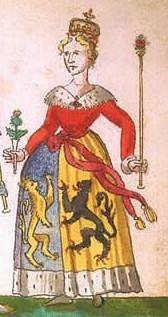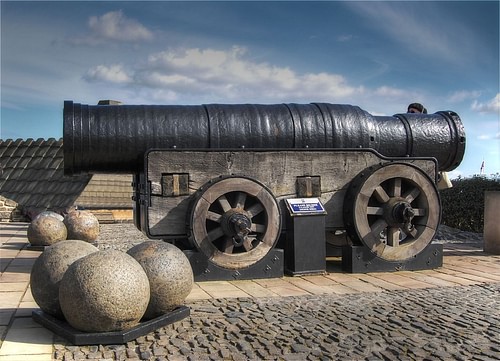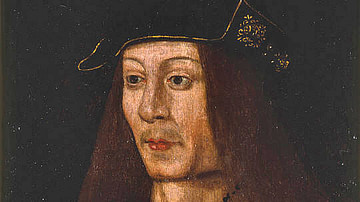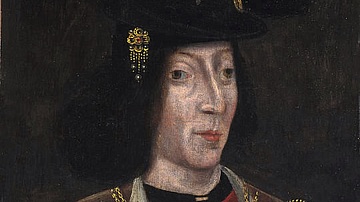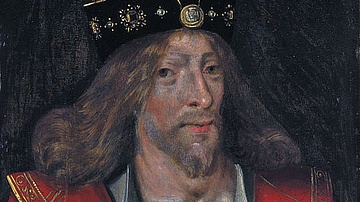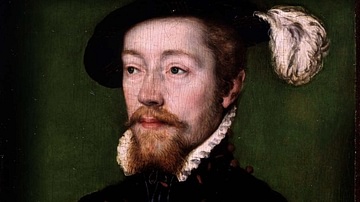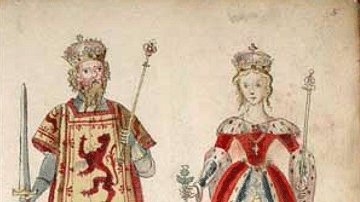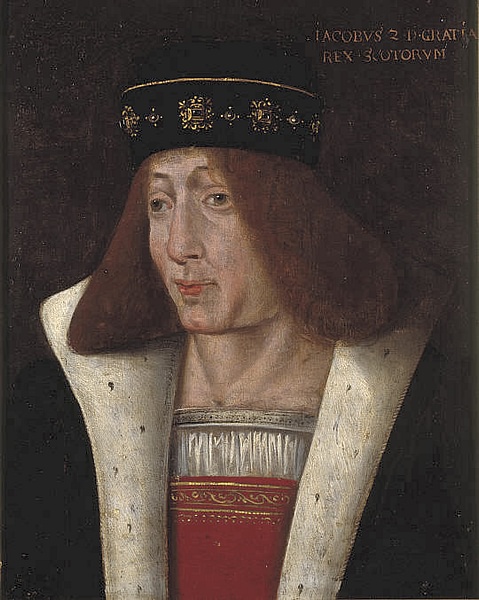
James II of Scotland ruled as king from 1437 to 1460. Succeeding his murdered father James I of Scotland (r. 1406-1437), James inherited the throne as a child. The first part of his reign witnessed intense rivalries between rival barons, which sent Scotland into a civil war. The young king was nicknamed 'fiery face' because of a prominent birthmark on his face. From 1449, James reached maturity and began to take control of his kingdom, and he skilfully fostered allies, reduced the wealth and power of rival families, and championed new military technology. Having eliminated all rivals and made several attacks on northern England, the king died aged just 29 in August 1460 when a cannon he was standing next to exploded. He was succeeded by his son James III of Scotland (r. 1460-1488).
Succession
James I had spent 18 years confined by the kings of England before he returned to Scotland in 1424. The king shook up the nobility of Scotland, punishing those who had been disloyal in his absence and reshaping the estates, titles, and particularly earldoms that had been in place for centuries. The monarch was autocratic and lived an extravagant lifestyle. Unpopular taxes and a humiliating failure to take Roxburgh Castle in 1436 added to the ill-feeling, and the king was assassinated in Perth in February of the next year.
James I's only son was born on 16 October 1430 in Holyrood Palace in Edinburgh and named after his father. Actually, there were twins, but the other boy, named Alexander, did not survive infancy. James junior gained the nickname 'fiery face' because of a large birthmark which covered the left side of his face, although he also became known for his fiery temper, too. Prince James' mother was Lady Joan Beaufort (c. 1400-1445), a niece of Henry IV of England (r. 1399-1413) and daughter of the Earl of Somerset. Fortunately, for Joan and Prince James, most of the nobility did not side with the murderers of James II and so the Stuart line continued to rule Scotland. Succeeding on 21 February 1437, James II was crowned on 26 March in Holyrood and not in the traditional site of Scone Abbey because of fears for the king's safety so far from the capital.
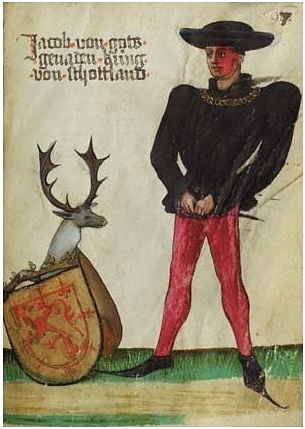
James was only six years old, and he would certainly have his work cut out to keep control of his kingdom. In the first instance, Earl Archibald Douglas, as James' closest adult male relative, became the King's Lieutenant-general or regent, and all was well. However, when Archibald died of a plague in June 1439, rivalries broke out between nobles, the queen and her second husband, the nobleman James Stewart (the 'Black Knight' of Lorne), and within the Douglas clan itself. As one historian notes, "documentary evidence for the 1440s is scanty, lending weight to the view that this was a time of turmoil" (Oram, 213).
Civil War
Over the next decade, three families, in particular, were a source of endless rivalries and shifting allegiances: the Crichtons (who controlled Edinburgh Castle), the Douglas earls and their wide network of family connections, and the Livingstons (who had entrenched themselves in the kingdom's administrative offices and who also controlled Stirling Castle). There were murders and executions on all sides. Then Queen Joan died in 1445. James' reign was about to get back on track, though, and the first step was on 3 July 1449 when he married the Burgundian noblewoman Mary of Gueldres (d. 1463), daughter of the Duke of Gueldres and niece of Philip the Good, the immensely powerful Duke of Burgundy. Not only did this union help trade relations with the Low Countries, but the king also acquired from Burgundy a useful number of cannons, including perhaps the famous Mons Meg, a giant cannon now on display in Edinburgh Castle.
In 1449, James reached maturity and wasted no time dealing with his cantankerous nobles. He stripped the Livingstons of much of their revenue-generating titles, but the chief threat was the Black Douglases who controlled three earldoms outright and insisted they had a legitimate claim to a fourth. The king took advantage of Earl William Douglas' pilgrimage to Rome in the autumn of 1450 to begin harassing Douglas lands and seizing key castles.
The decisive moment in James' reign came in February 1452 when James invited William Douglas to Stirling Castle. The earl was promised safe conduct but the king, suspecting him of making treasonable alliances with a number of northern barons, got into a heated argument and stabbed him in the neck; his courtiers then finished off the earl. One medieval chronicler recorded that the earl's body had 26 stab wounds. Parliament absolved the king of any intention to kill the earl in June 1452, but a civil war followed anyway between the Black Douglases and those nobles loyal to the king (which included the Red Douglases of Angus). James put his cannons to good use and finally won the war three years later with the decisive Battle of Arkinholm and the capture of the last Douglas stronghold, Threave Castle. Senior members of the Douglas family were killed in action, executed, or exiled, and their estates were confiscated and redistributed to the king's two sons, John and Alexander.
Attacks on England
Apart from finally creating peace in his kingdom, James' other achievements included centralising his government, making the justice system more effective, increasing royal control over church appointments, and founding a new university in Glasgow in 1451. The king also took advantage of the disruption caused by the civil war in England now known as the Wars of the Roses (1455-1487) to attack lands on the other side of his southern border. Now that the Douglases had been put in their place, James could concentrate on using his armies outside Scotland. Notable targets were Berwick in 1455 and 1457, and the Isle of Man in 1456. None of these attacks was particularly successful, even if Northumberland was plundered, and a series of truces followed between the two countries.
At the end of July 1460, James, still very much enamoured with artillery and back on the warpath, laid siege to Roxburgh Castle, a mighty fortress that had seen a Stuart king come a cropper in the past. On 3 August, standing next to one mighty cannon, the king was killed when it exploded and a huge piece of iron sliced through his thigh bone. Ironically, the cannon was not even fired in anger but had been set off as a salute to the arrival of the queen at the siege, invited there by the king, such was his confidence in victory. At least Queen Mary pressed on with the siege and brought it to a successful conclusion five days later. James II was then buried at Holyrood.
Successor
Following his father's death, the king's eldest son James (b. May 1452) became James III of Scotland. He was only eight years old and so his mother, Queen Mary, took charge of the kingdom. The queen died in 1463, and this was the opportunity for ambitious nobles to stake their claim to the throne. James III was effectively kidnapped while out hunting by the courtiers Alexander and Robert Boyd. The Boyd brothers even convinced their captive to marry the daughter of the King of Norway. When James reached maturity in 1469, the Boyd brothers got their comeuppance, and they were tried and found guilty of treason. Robert managed to escape to England, but Alexander was executed. The king would yet suffer another kidnapping, and the Scottish nobles once again squabbled for ultimate power. James III was killed in 1488, possibly by accident after a skirmish. The Stuarts were nothing if not resilient, though, and the line continued with James' son who became James IV of Scotland (r. 1488-1513).
